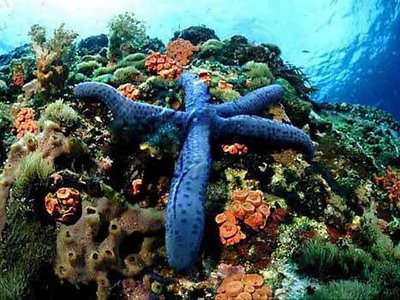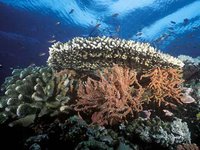 I have never tried diving yet although I have always wanted to. And obviously, with so much marine biodiversity in the Philippines, I'm missing a lot. The closest thing I've ever done was walk a few meters from the shore in full scuba gear during a high school class outing in the Eagle Point Resort in Batangas. We also got to snorkel off the coast of Anilao, close to Maricaban and Sombrero Islands. But that was it.
I have never tried diving yet although I have always wanted to. And obviously, with so much marine biodiversity in the Philippines, I'm missing a lot. The closest thing I've ever done was walk a few meters from the shore in full scuba gear during a high school class outing in the Eagle Point Resort in Batangas. We also got to snorkel off the coast of Anilao, close to Maricaban and Sombrero Islands. But that was it. Which is why I was encouraged further when I found out that the Verde Island Passage, which was just a few kilometers away, is now recognized by scientists as "the center of the center of the center of the world's marine shore fish biodiversity."
Which is why I was encouraged further when I found out that the Verde Island Passage, which was just a few kilometers away, is now recognized by scientists as "the center of the center of the center of the world's marine shore fish biodiversity."Just to give everyone a backgrounder on the title, the Sulu-Sulawesi Seascape is recognized by the scientific community as the center of the highest concentration of marine biodiversity in the world. Occupying an area of 900,000 square kilometers in the Philippines, Indonesia and Malaysia, it is "at the heart of the coral triangle which accounts for 50 percent of the world’s coral reefs," a Philippine Daily Inquirer article reported.
 Comparative studies of marine concentration in the Indo-Malaya-Philippines archipelago show that central Philippines, which includes the Tubattaha Reef, a UNESCO world heritage site, is the center of that center of marine biodiversity. It was American marine biologist Kent Carpenter of the World Conservation Union, and fellow researcher Victor Springer of the Smithsonian Institution who discovered in 2004 that the center of the center of marine shore fish biodiversity in the world was the Philippines, and not Indonesia.
Comparative studies of marine concentration in the Indo-Malaya-Philippines archipelago show that central Philippines, which includes the Tubattaha Reef, a UNESCO world heritage site, is the center of that center of marine biodiversity. It was American marine biologist Kent Carpenter of the World Conservation Union, and fellow researcher Victor Springer of the Smithsonian Institution who discovered in 2004 that the center of the center of marine shore fish biodiversity in the world was the Philippines, and not Indonesia. And it was determined that the center of the center of the center of that marine biodiversity was the Verde Island Passage corridor, which was found to have the largest concentration of marine life in the world with a recorded 1,736 overlapping marine species in a 10 by 10 kilometer area. Verde Island is thus dubbed by scientists as "the world’s blue water version of the Amazon River basin."
And it was determined that the center of the center of the center of that marine biodiversity was the Verde Island Passage corridor, which was found to have the largest concentration of marine life in the world with a recorded 1,736 overlapping marine species in a 10 by 10 kilometer area. Verde Island is thus dubbed by scientists as "the world’s blue water version of the Amazon River basin."For more information, check out the article RP world center of marine treasures. Looks like I'll consider diving in the near future. Hehe! (Photos from Scott Tuason; Diving in the Philippines and Yvette Lee, PDI)

I have seen this on TFC but your post give more and better information than that of TFC.
ReplyDeleteI have been to that place many times and likewise been passing that place going to Mindoro from Batangas and never thought that in those blue water lies the world’s blue water version of the Amazon River basin."
Come to think of it, it is not only me but most of us Filipinos do not know this fact.
I only wish people should take care of this center of the center of the center of the world;s marine shore fish biodiversity.
Kaya pala magaganda at ibat ibang kulay ang mga isda at iba pang lamang dagat ang makikita doon.
as of now im planning to make my thesis proposal regarding marine research and protection center. I think it will be a best place for it. Ang ganda ng philippines and many pilipinos dont know about it :)
ReplyDelete